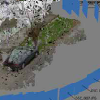A combined GIS and stereo vision approach to identify building pixels in images and determine appropriate color terms
Keywords:
GIS, computer vision, stereo depth mapping, color terms, building facade, structure from motion, wayfinding instructions, color entropyAbstract
Color information is a useful attribute to include in a building's description to assist the listener in identifying the intended target. Often this information is only available as image data, and not readily accessible for use in constructing referring expressions for verbal communication. The method presented uses a GIS building polygon layer in conjunction with street-level captured imagery to provide a method to automatically filter foreground objects and select pixels which correspond to building facades. These selected pixels are then used to define the most appropriate color term for the building, and corresponding fuzzy color term histogram. The technique uses a single camera capturing images at a high frame rate, with the baseline distance between frames calculated from a GPS speed log. The expected distance from the camera to the building is measured from the polygon layer and refined from the calculated depth map, after which building pixels are selected. In addition significant foreground planar surfaces between the known road edge and building facade are identified as possible boundary walls and hedges. The output is a dataset of the most appropriate color terms for both the building and boundary walls. Initial trials demonstrate the usefulness of the technique in automatically capturing color terms for buildings in urban regions.

Downloads
Published
Issue
Section
License
Articles in JOSIS are licensed under a Creative Commons Attribution 3.0 License.
